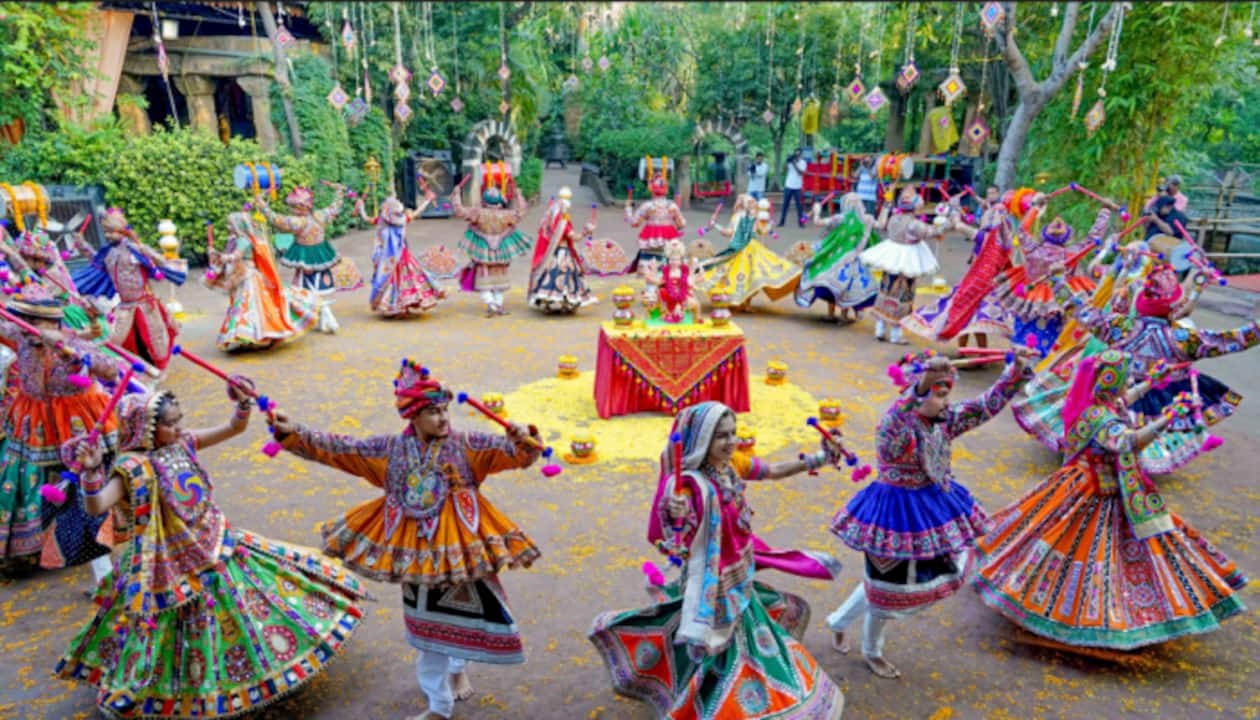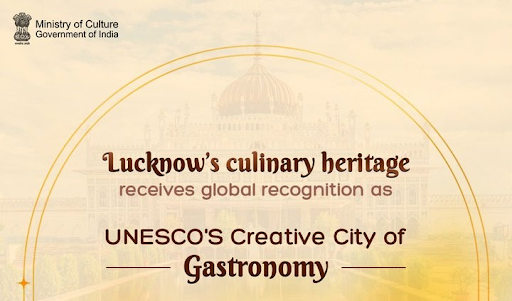Description

Disclaimer: Copyright infringement not intended.
Context
- The inscription of 'Garba of Gujarat' on the Representative List of Intangible Cultural Heritage (ICH) of Humanity by UNESCO during the 18th meeting of the Intergovernmental Committee for the Safeguarding of the Intangible Cultural Heritage held in Kasane, Botswana, from 5th to 9th December 2023.
Details
- UNESCO Recognition: 'Garba of Gujarat' becomes the 15th ICH element from India to join the UNESCO list, signifying its cultural significance and role in fostering social inclusivity.
- UNESCO Acknowledgment: The Evaluation Body of the 2003 Convention praised India's dossier for 'Garba of Gujarat' with outstanding supporting material, recognizing its ability to promote unity in diversity and social equality among communities.
- UNESCO's Listing Mechanism: The UNESCO 2003 Convention aims to enhance visibility, create awareness about the significance of intangible cultural heritage, and promote dialogue that respects cultural diversity.
- India's Role: India, elected to be part of the 24 Member Inter-governmental Committee (IGC) of the ICH 2003 Convention in 2022, played a role in nominating and supporting 'Garba of Gujarat' for inscription.

About Garba
Etymology and Symbolism:
- Etymology: The term "Garba" is derived from the Sanskrit word for "womb," symbolizing gestation, life, and fertility.
- Garbha Deep: A clay lantern with a light inside, representing the womb, life, and the fetus. Dancers honor the feminine divinity, particularly Goddess Durga, by performing around this lantern.
- Symbolism in Dance: Garba is performed in circular formations, symbolizing the cyclical nature of time in Hinduism. It represents the constant cycle of birth, life, death, and rebirth, with the unmoving symbol of the Goddess amidst this perpetual movement.
- Historical Origins: The dance form has its roots in the folk traditions of Gujarat, tracing back centuries as a ritualistic dance worshipping the goddess Durga or Amba.
Dance Form and Attire:
- Circular Dance: Dancers perform in concentric circles, maintaining synchronization and graceful movements.
- Attire: Women wear colorful chaniya choli, embroidered blouses with flared skirts, accessorized with jewelry like jhumkas, necklaces, and bangles. Men traditionally wear kediyu, a traditional outfit with a short round kurta above the knees and a pagadi on the head.
Evolution and Modern Influences:
- Dandiya Raas Influence: Garba has been influenced by Dandiya Raas, a dance traditionally performed by men. The combination of Garba and Dandiya Raas has led to the high-energy dance seen today.
- Global Reach: Garba's popularity has expanded globally, especially among the Gujarati diaspora. It is celebrated in various countries, with significant events in the United States, Canada, and the United Kingdom.
Characteristics of Garba:
- Music and Rhythm: Garba is accompanied by energetic and rhythmic music, often using traditional instruments like dhol, tabla, and dandiya sticks.
- Dress and Attire: Dancers typically wear colorful traditional attire such as chaniya choli for women and kediyu for men, adorned with intricate embroidery and mirror work.
- Circular Dance: Participants form concentric circles or formations and perform graceful and synchronized circular dance movements.
Navaratri Celebrations and Garba:
- Nine Nights of Festivity: Navaratri is celebrated with great fervor, where communities come together to perform Garba every night for nine consecutive days.
- Traditional Rituals: The dance is a part of various rituals during Navaratri, symbolizing the triumph of good over evil and the worship of feminine divinity.
About ICH
Definition and Characteristics:
- UNESCO Recognition: UNESCO defines Intangible Cultural Heritage as practices, expressions, representations, knowledge, and skills acknowledged by communities, groups, and sometimes individuals as part of their cultural heritage.
- Living Cultural Heritage: It is often termed as living cultural heritage and is manifested in domains such as oral traditions, performing arts, social practices, rituals, traditional craftsmanship, and knowledge about nature and the universe.
Categories of Intangible Cultural Heritage:
- Oral Traditions and Expressions: Language and oral traditions as vehicles of intangible cultural heritage.
- Performing Arts: Various performing arts forms and traditions worldwide.
- Social Practices, Rituals, Festive Events: Cultural practices associated with social events and celebrations.
- Nature and Universe Knowledge: Traditional knowledge about nature, biodiversity, and the universe.
- Traditional Craftsmanship: Skills and practices in traditional crafts and craftsmanship.
Preservation and Protection:
- UNESCO Convention: The Convention for the Safeguarding of the Intangible Cultural Heritage was drafted in 2003 for the protection and promotion of ICH.
- Legislative Measures: Several countries have introduced legislation to safeguard intangible cultural heritage, such as Japan's law for the protection of cultural properties.
Cultural Elements as ICH:
- Food Heritage: Culinary traditions like the Mediterranean diet, traditional Mexican cuisine, and Japanese washoku are recognized as intangible cultural heritage.
- Dance Heritage: Various dance genres worldwide, from celebratory and ritual dances to social dances, are included in the UNESCO lists of intangible cultural heritage.
Challenges and Debates:
- Intellectual Property Rights: Debate surrounds the protection of intangible cultural heritage through intellectual property rights, addressing issues of commodification and legal frameworks.
- Sustainability and Preservation: Efforts are ongoing to sustainably preserve and promote these cultural elements while respecting community practices and identities.
Overview of the 14 traditions and rituals from India included on the 'Intangible Cultural Heritage of India' list:
- Ramlila (2008): Traditional performance of the Ramayana during the Autumn festival of Dussehra, recounting episodes from the epic through dialogue, narration, recital, and song.
- Tradition of Vedic chanting (2008): Recitation of Sanskrit Vedas, symbolizing ancient cultural traditions and the foundation of Hinduism, practiced with specific tonal accents and pronunciation.
- Kutiyattam, Sanskrit theatre (2008): A 2,000-year-old theatrical tradition from Kerala, combining Sanskrit classicism with local elements, featuring extensive training for performers.
- Ramman, religious festival and ritual theatre of the Garhwal Himalayas (2009): Celebrating the guardian god Bhumiyal Devta through music, theatre, and historical reconstructions in the villages of Saloor-Dungra, Uttarakhand.
- Mudiyettu, ritual theatre and dance drama of Kerala (2010): An annual ritual dance drama performed in Kerala villages based on the battle between the goddess Kali and the demon Darika.
- Kalbelia folk songs and dances of Rajasthan (2010): Expressive dances by the Kalbelia tribe from the Thar Desert, symbolizing their traditional way of life and adapting to socio-economic changes.
- Chhau dance (2010): Traditional dance form from eastern India, enacting local folklore, epics, and featuring distinct styles from different regions.
- Buddhist chanting of Ladakh (2012): Recitation of sacred Buddhist texts in the Ladakh region, representing different sects and forms of Buddhism.
- Sankirtana, ritual singing, drumming, and dancing of Manipur (2013): Art forms celebrating religious occasions and life stages of the Vaishnava people, promoting community bonding.
- Traditional brass and copper craft of utensil making among the Thatheras of Jandiala Guru, Punjab (2014): Skilled craftsmen practicing traditional brass and copper utensil-making techniques, defining their livelihood and community status.
- Yoga (2016): An ancient practice involving postures, meditation, controlled breathing, and chanting for holistic well-being, influencing Indian society's health, education, and arts.
- Traditions of Nawruz (Parsi New Year) (2016): Celebrations marking the Parsi New Year with rituals, ceremonies, and cultural events symbolizing brightness, purity, and livelihood.
- Kumbh Mela, North India (2017): The world's largest spiritual congregation held every four years, where devotees bathe in holy rivers to absolve sins and gain spiritual freedom.
- Durga Puja, Kolkata (2021): Annual festival in honor of the Hindu goddess Durga, celebrated with sculpting figurines, rituals, and immersion of the goddess in rivers.

Conclusion
Overall, the inscription of 'Garba of Gujarat' on UNESCO's Representative List of Intangible Cultural Heritage acknowledges its cultural depth, social significance, and the role it plays in uniting communities, furthering India's rich heritage on the global stage.
|
PRACTICE QUESTION
Q. India boasts a rich tapestry of Intangible Cultural Heritage recognized by UNESCO. Discuss and elaborate on any three elements from the Intangible Cultural Heritage of India list, emphasizing their historical, cultural, and social significance. How do these elements contribute to India's cultural diversity and identity? (250 Words)
|















